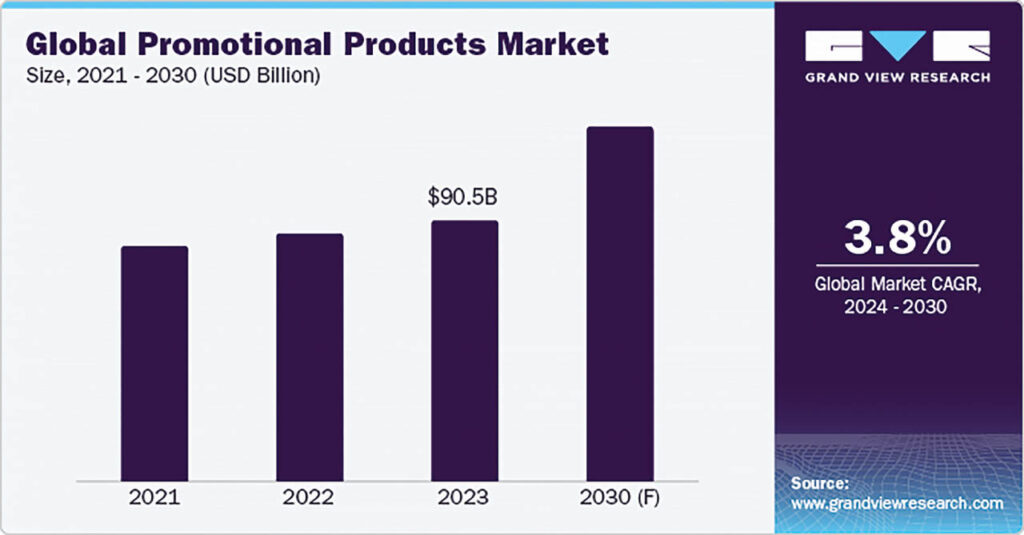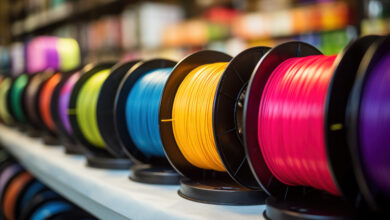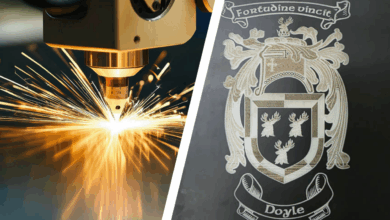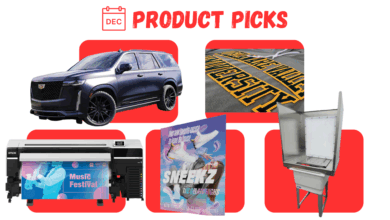Let’s be honest: Baby Boomer-era promotional products like branded jar openers and cheap plastic frisbees are as unappealing now as they were in years past. In a day and age when TikTok determines what is trending today and sayonara tomorrow, modern consumers expect more in style and substance from the brands they support — even when it comes to promotional products.
As Gen X, millennials, and Gen Z take the lead in promotional product ownership, businesses must be in lockstep with the customers they are courting. After all, brand engagement and loyalty depend on it. Tune in with top industry professionals as they lend their expert advice on significant market shifts, current trends, and future dynamics.
State of business
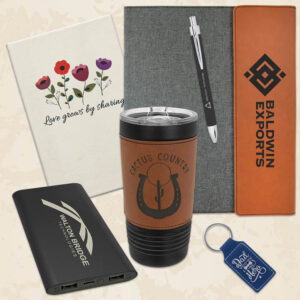
According to Grand View Research, the global promotional products market size was valued at $90.5 billion in 2023 and is projected to grow at a compound annual rate of 3.75% between 2024 and 2030. While the promotional products industry were expected to finish relatively flat year over year in 2024, companies like Gemline and The Rowmark Group (TRG) are outpacing the overall market.
“In 2024, we saw about a 7% increase in the gift and promotional products category,” noted Jackie Faeth, marketing coordinator at TRG.
Major sectors like healthcare, non-profit organizations, real estate, education, finance, and government are driving demand, as branded promotional products are gifted to a variety of clientele. Many organizations turn to tried-and-true, industry-specific items, from customized ice packs, medication boxes, and first aid kits to wristbands, lanyards, tote bags, tumblers, and even retro-inspired fanny packs.
“At their core, promotional products are advertising vehicles — building brand affinity and fostering a sense of community. To be truly successful, though, it must resonate with the recipient, ensuring it is kept and used repeatedly,” said Saadia Bryant, vice president of marketing, product, and design at Gemline.
Post-COVID-19, she sees a significant increase in demand for retail brands and “a general flight to quality products” across the board.
“Partnering with well-known, reputable brands for promotional products ensures that items are not only of high quality but also trusted by consumers. These partnerships lend credibility and status to the promotional campaigns, allowing companies to align with brands that reflect their own values — whether that’s sustainability, innovation or reliability,” according to Hit Promotional Products — a promotional products provider for over 50 years. “Furthermore, as people gravitate toward items they already know and love, incorporating recognizable brands into promotional strategies can elevate a brand’s image and increase consumer loyalty.”
Today — in an increasingly competitive market easily impacted by the changing tides of economic conditions — businesses are challenged to conserve marketing dollars without compromising quality. Gemline witnessed this trend play out in real-time during 2024, as the sales process was extended due to companies being more mindful of every penny spent.
“Across multiple categories, we are seeing momentum in affordable, value-driven products with strong quality characteristics,” added Frank Carpenito, president and CEO at Gemline. “Think of the Trader Joe’s model and appeal.”
While striking a balance between quality and affordability may feel like walking a tightrope, shop owners are encouraged to stay the course: maximize proven promotional product sales, study current market trends, and diversify accordingly.
’Tis the season
Seasonality undeniably plays a critical role in annual promotional product sales. During winter, companies may be focused on outerwear, holiday gifts, and calendar magnets, while spring brings a resurgence of canopy tents, table throws, pop-up podiums, and tradeshow giveaways. T-shirts, baseball hats, and golf and running gear rule the summer, but lunch boxes, totes, backpacks, and pens are hot ticket items during back-to-school.
“At Stouse, we keep the sales cycle in mind when promoting our product line to shop owners, ensuring they have plenty of time to stay on trend and offer seasonal items to their customers,” said Jennifer Hoyt, director of marketing and e-commerce at Stouse. “We also recommend balancing these seasonal items with evergreen products like stickers or roll labels, providing value at any time of the year. This mix allows shop owners the ability to maintain a relevant offering while appealing to a wide range of customer needs.”
Materials
As the promotional product selection evolves, so do the materials. From glass and acrylic to wood and metal, sophisticated technology is redefining the category at large and raising the bar in quality, durability, and turnaround time.
Mike May, president at JDS Industries, pointed to leatherette as an increasingly popular material, which can be engraved or directly printed in full color. He says customization methods like sublimation, direct print, and laser engraving are on the rise, with a product selection that spans manicure sets, passport covers, portfolios, phone wallets, key chains, luggage tags, and more.
In addition, Hoyt notices a trend in creative materials like holographic and glitter decals, which add “a fun, eye-catching element to branding.”
“Stickers and decals have enjoyed quite the comeback in recent years,” she noted. “At Stouse, we offer a wide variety of materials, ranging from classic white vinyl to eye-catching chrome and holographic glitter. Our printed product line includes everything from everyday paper roll labels used for food products to ultra-sticky, extra-durable decals used for applications like marking recycling containers.”
Tech-driven
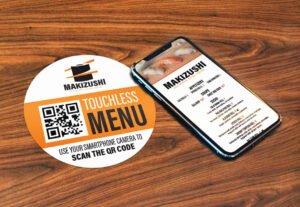
Recent data also shows an uptick in promotional products and gifts that combine utility and innovation. As such, more companies are exploring practical items that not only put the brand front and center but also double as thoughtful everyday items. Industry professionals point to Bluetooth-enabled speakers, earbuds, wireless charging pads, power banks, phone chargers, and smart water bottles with hydration tracking features as effective ways to increase brand awareness among a tech-savvy consumer base.
Within health and wellness, for example, companies are turning to promotional products that encourage healthy habits and promote a balanced lifestyle, such as branded fitness trackers, aromatherapy sets, and ergonomic office accessories.
These desirable products complement the flexible and connected lifestyle of modern customers, while simultaneously applauding a business’ commitment to “a forward-thinking brand image,” according to Grand View Research.
In addition, Hoyt calls attention to complementary tech-oriented trends like QR codes, which drive engagement while promoting a brand or service. They are increasingly popular across various markets and product applications. For example, Hoyt said restaurants print them on promotional decals to facilitate online menus and ordering; pharmacies use them on signage to encourage immunization registration; and ride-share companies partner with bars to encourage safe transportation options.
Customized with care
In addition to an ever-expanding product selection, enhanced customization is all the rage. Shifting demographics and consumer preferences, along with increased e-commerce purchasing habits, are influencing demand in categories like personalized apparel, home decor, accessories, and drinkware.
“We continue to see steady year-over-year growth in the drinkware category, but with an interesting uptick in the drinkware accessories category like coasters,” Faeth stated. “We also see higher quality home and kitchen products in greater demand due to the saturation of the market with smaller items that have a lower perceived value, like the traditional pens or plastic cups.”
Industry professionals encourage companies to think like consumers and gift what they would like to be gifted, from high-end, leather-bound journals or comfortable wool socks to fine throws, picnic blankets, and hand-crafted seasonal items that can be used or displayed year after year.
“Ornaments! Ornaments! Ornaments! This is a category that is here to stay — and can be used beyond the holiday,” Faeth explained, noting many realtors gift a “Welcome Home” or “First Christmas” ornament at property closings throughout the year.
Data shows personalization in any form, from embroidered or monogrammed initials to laser-engraved messages, creates a feeling of exclusivity and enhances the emotional connectivity between businesses and recipients.
Sustainability
More than ever, consumers are looking for authenticity and ethical responsibility from the brands they choose to support. Products that support sustainability initiatives or charitable causes will not only positively promote a brand, but also foster a deeper connection with audiences who value purpose over profit, according to Hit Promotional Products.
“It’s more than a trend — it’s a strategic imperative,” added Kaeser & Blair Incorporated — a family-owned-and-operated business within the promotional products industry since 1894. “By prioritizing sustainable promotional products that align with company brand values, you can resonate with your eco-conscious customers.”
From reusable straws and cutlery sets to recyclable tote bags to biodegradable pens and notebooks, the environmental focus is a “trend” with staying power. Over the past two years, Carpenito says millennials and Gen Z purchasers, in particular, are demanding more non-landfill products and greater transparency with the brands they purchase.
As a result, “We do see CSR/ESG considerations factoring more and more into purchase decisions for larger enterprise companies,” added co-worker Bryant. “They want to purchase products that have lower impact and are better for the environment.”
“Now, we’re even providing carbon footprint information at the item level, so customers can make more informed purchasing decisions,” she added.
Invest for success
Modern digital tools like state-of-the-art equipment and e-commerce will continue to direct individual business success in the years ahead.
“At Stouse, we’ve seen a dramatic shift from a technology standpoint. Most of our products were screen printed at one time. Now, we’re continuously investing in digital printing equipment to provide our customers with high quality, outdoor-durable, printed items,” Hoyt said, noting production processes and times have evolved as well to maintain demand.
Industry professionals anticipate a steady year in promotional product sales — thanks, in part, to the increased accessibility of more affordable equipment. Faeth and May both expect UV-LED, plus direct-to-garment and direct-to-film printing technologies “to take off in 2025.”
“This technology is now available in smaller units and allows for quick, on-demand, full-color printing on a wide array of materials and surfaces,” Faeth remarked, emphasizing other color printing methods are effective but have some limitations.
Likewise, building, promoting, and maintaining a strong brand through a company website, social media, proper SEO, and e-mail campaigns is a necessary part of doing business these days.
“Millennials and Gen Z purchasers care less about face-to-face sales interactions and do not value vendor-customer relationships as much as older generations do, so transacting online has become a very viable method for them to order promotional products,” Carpenito explained.
From a B2C perspective, Faeth said having an attractive, easy-to-use web setup along with e-commerce capabilities is “imperative to survival” in today’s marketplace. The same is true for B2B, with suppliers like TRG understanding time is money for businesses who need to find new products or reorder quickly with little to no barriers, especially during peak seasons.
More importantly, a strong website and e-commerce presence is a constant work in progress.
“While our website has provided customers with real-time updates for over a decade, we’ve recently added new features like an online design tool to make the distributor experience similar to the B2C e-commerce interfaces,” Hoyt said. “This enhancement also streamlines the ordering process and improves turnaround time to ensure we continue to service our distributors quickly.”
May encourages business personnel to utilize supplier marketing resources like editable/sharable PDF files, digital imagery, online flipbooks, and e-catalogs to boost their digital efforts and reach a larger audience. Failing to tap into the wealth of materials available is a missed opportunity.
Looking ahead at the promotional products industry
Industry suppliers are closely monitoring tariff expansion across the globe, which would inevitably impact the cost of sourcing products off-shore.
“Another threat to the personalization market is potential supply chain interruptions, particularly with products that are manufactured overseas,” Faeth said. “Working with a company that deals with the import process and has a diverse option of both U.S. and overseas vendors can help avoid this pain point.”
While the overall cost of shipping continues to increase at a higher rate than general inflation, industry suppliers like Gemline, JDS Industries, and TRG are optimistic and preparing to launch hundreds of new products between them.
As the pros kickstart 2025 with a bang in promotional products, Faeth encourages business owners to stay abreast of current market trends without letting them control all creative direction.
“Explore a niche that works for you,” she said. “Start by finding one product and do that really well, then slowly and strategically add on.”

